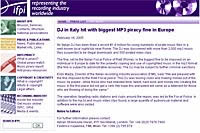 A “well known” Italian DJ could be hit with a record-breaking fine of up to 1.4 million euros ($1.8 million, £968,000) for using thousands of pirate music files in a nightclub near Rome, police said on Wednesday.
A “well known” Italian DJ could be hit with a record-breaking fine of up to 1.4 million euros ($1.8 million, £968,000) for using thousands of pirate music files in a nightclub near Rome, police said on Wednesday.
Police in the town of Rieti, near Rome, said they raided a popular nightclub earlier this week as part of a king-size crackdown on piracy and seized 500 illegally copied music videos and more than 2,000 MP3 music files.
The get-tough operation, targeting radio stations and clubs around the region, was led by the Fiscal Police (Guardia Di Financa, that deal with financial crime), who also seized a large quantity of “audiovisual material” and software.
There are a lot of inaccurate reports floating around about this and we wanted to get the full story, so called up the FIMI in Italy. They told us that the copyright law in Italy dates back to 1941 but was most recently updated a year ago. Under the law the DJ was fined 100 Euro ($130, £69) per copied track, this figure was then doubled to 500,000 Euro. Only if the fine is not paid within 60 days, will it increase to 1.4m.
The reason for the doubling was unclear. Under Italian law, the precise details of the case are not made public until the case comes to court.
The DJ is free to appeal against the fine. Once the fine has been finalised, the money can be paid off monthly.
“For the MP3 files, which were kept on the DJ’s personal computer, the DJ has received a fine of 1.4 million euros,” Rieti finance police said in a statement (the fine is subject to administrative recourse). The DJ may also be subject to further criminal sanctions.
The International Federation of the Phonographic Industry (IFPI) said the fine was the biggest ever slapped on an individual for unlawful music copying and the use of copyrighted music in the MP3 format.
“We are pleased with the fine imposed by the Rieti Fiscal police,” said Director of the Italian Recording Industry Association (FIMI) Enzo Mazza.
He continued, “This deejay was touring clubs and making money out of the music he played – while those who had invested time, talent, hard work and money into creating the music in the first place did not get a cent. We hope this precedent will serve as a deterrent for those who are thinking of doing the same.”
Seeing as venues already pay money to the collection societies for public dance licenses we find the size of this fine a little baffling.
It could certainly be argued that DJs can act as ambassadors for new music (and therefore the music companies) with some high-profile DJs having a considerable influence on the record buying public.
After all, why else would record companies ply DJs with endless vinyl/promos and other inducements in the hope of getting their tunes played?
Perhaps now that times are more lean for the record companies, they’re cutting back on the freebies.
It appears the line between theft and promotion can sometimes be a blurred one, and we’re not convinced that punishing DJs with such enormous fines is the way the record industry should be protecting their sales…
 The Internet! It’s stuffed full of evil kiddie fiddlers and dodgy geezers out to grab our children!
The Internet! It’s stuffed full of evil kiddie fiddlers and dodgy geezers out to grab our children!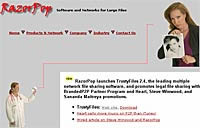 TrustyFiles also keeps an eye on users’ Web habits, spawning a warning message when a user enters a search term known to be associated with child pornography.
TrustyFiles also keeps an eye on users’ Web habits, spawning a warning message when a user enters a search term known to be associated with child pornography.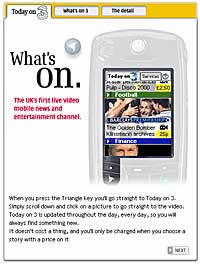 UK 3G operator
UK 3G operator 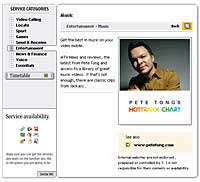 Not all of these videos will be available concurrently, however, as 3 have an editorial team selecting popular content for their
Not all of these videos will be available concurrently, however, as 3 have an editorial team selecting popular content for their 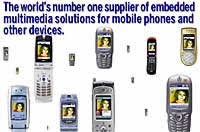 In their 2005 “State of the Company” address just made public,
In their 2005 “State of the Company” address just made public,  PacketVideo specialises in building and ‘commercializing’ (we think that’s American for “selling”) multimedia capabilities such as VOD, music on demand (MOD) and two-way video communication and messaging.
PacketVideo specialises in building and ‘commercializing’ (we think that’s American for “selling”) multimedia capabilities such as VOD, music on demand (MOD) and two-way video communication and messaging.
 The Smart2Go Personal Navigator is claiming to be the first mobile navigation system to combine satellite navigation with an extensive travel guide. For travellers who don’t know their A-Z from their GPS, the Personal Navigator promises to make finding your way around town a breeze, with routes, directions and 3D maps being generated at a click of a button on your PDA/smartphone.
The Smart2Go Personal Navigator is claiming to be the first mobile navigation system to combine satellite navigation with an extensive travel guide. For travellers who don’t know their A-Z from their GPS, the Personal Navigator promises to make finding your way around town a breeze, with routes, directions and 3D maps being generated at a click of a button on your PDA/smartphone. Additionally, Personal Navigator can also provide recommendations, updated daily, for events in culture, sports and more – and if you fancy meeting up with your friends, smart2go can send them route details by sms or e-mail.
Additionally, Personal Navigator can also provide recommendations, updated daily, for events in culture, sports and more – and if you fancy meeting up with your friends, smart2go can send them route details by sms or e-mail. In response to demand from emerging markets the
In response to demand from emerging markets the 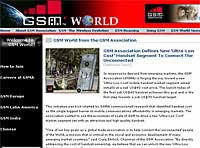 The next stage of the project will see the project extended to other emerging market operators, while more vendors will be encouraged to supply terminals for this sizable segment.
The next stage of the project will see the project extended to other emerging market operators, while more vendors will be encouraged to supply terminals for this sizable segment.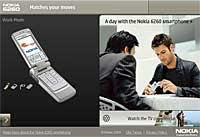 In return Microsoft will also be supporting OMA DRM and AAC music format in their Windows Media player, via a plug in.
In return Microsoft will also be supporting OMA DRM and AAC music format in their Windows Media player, via a plug in. There’s a big future in locations-based services and Nokia are making their move to provide technology for it. As part of the Nokia mPosition System, Nokia is rolling out the Nokia intelligent Gateway Mobile Location Center (iGMLC) 4.0.
There’s a big future in locations-based services and Nokia are making their move to provide technology for it. As part of the Nokia mPosition System, Nokia is rolling out the Nokia intelligent Gateway Mobile Location Center (iGMLC) 4.0.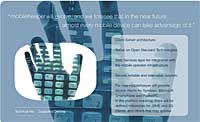 If you’ve ever had your phone stolen, left it in a cab or, like a colleague of ours, managed to send it spinning down the u-bend whilst attempting a tricky feat of toilet-based multi-tasking, you’ll know the pain of unexpectedly parting company with your phone.
If you’ve ever had your phone stolen, left it in a cab or, like a colleague of ours, managed to send it spinning down the u-bend whilst attempting a tricky feat of toilet-based multi-tasking, you’ll know the pain of unexpectedly parting company with your phone.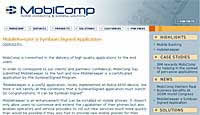 Working as extended storage for the mobile device, the application offers “over the air” data backup for the mobile device allows storage and recovery of contacts, calendar, tasks, SMS, MMS, ring tones, images, videos, J2ME applications and anything else you can fit on your phone.
Working as extended storage for the mobile device, the application offers “over the air” data backup for the mobile device allows storage and recovery of contacts, calendar, tasks, SMS, MMS, ring tones, images, videos, J2ME applications and anything else you can fit on your phone.